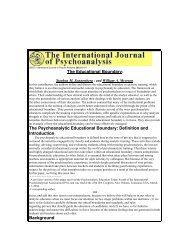A Companion to Linear B - The University of Texas at Austin
A Companion to Linear B - The University of Texas at Austin
A Companion to Linear B - The University of Texas at Austin
Create successful ePaper yourself
Turn your PDF publications into a flip-book with our unique Google optimized e-Paper software.
§12.2.5 SCRIBES, SCRIBAL HANDS AND PALAEOGRAPHY 123<br />
<strong>The</strong> extant tablets from Pylos, in cases where their contents and contexts are<br />
best unders<strong>to</strong>od, suggest th<strong>at</strong> there was a hierarchy <strong>of</strong> tablet-writers according<br />
<strong>to</strong> their pr<strong>of</strong>iciency <strong>at</strong> recording inform<strong>at</strong>ion accur<strong>at</strong>ely and effectively. <strong>The</strong> main<br />
scribes <strong>of</strong> each <strong>of</strong> the three palaeographical classes cover diverse <strong>to</strong>pics and<br />
were entrusted with the more important administr<strong>at</strong>ive assignments. Of course,<br />
we must always remember th<strong>at</strong> our view is limited <strong>to</strong> the period <strong>of</strong> <strong>at</strong> most<br />
5 months 162 from which our surviving tablets come. A scribe like Hand 21<br />
writes 72 tablets in <strong>at</strong> least six different spheres <strong>of</strong> activity. Hand 25, by contrast,<br />
has written a single tablet (Vn 20) dealing with wine alloc<strong>at</strong>ion <strong>to</strong> the<br />
principal districts <strong>of</strong> the Hither Province.<br />
Before we consider an example, we should say a few words <strong>of</strong> caution.<br />
New finds (or even joins) <strong>of</strong> tablets have <strong>of</strong>ten brought new revel<strong>at</strong>ions th<strong>at</strong> have<br />
overturned old theories. Two conspicuous examples are: (1) the clear <strong>at</strong>test<strong>at</strong>ion<br />
<strong>of</strong> the god Dionysus in the texts from Khania (Gq 5) and in a new join from Pylos<br />
(Ea 102) 163 th<strong>at</strong> overturned theories th<strong>at</strong> this god entered the Greek pantheon in<br />
post-Mycenaean times; (2) the discovery in the <strong>The</strong>bes tablets (Av 106) <strong>of</strong> our<br />
first clear reference <strong>to</strong> lyre players, long known <strong>to</strong> exist from wall and vase<br />
paintings and the finds <strong>of</strong> the remains <strong>of</strong> the instruments themselves. 164<br />
A prominent individual <strong>at</strong> Pylos known as a-ko-so-ta is recorded as performing<br />
an inspection <strong>of</strong> fields (Eq 213), as having received <strong>at</strong> least sixty-two <strong>of</strong> an<br />
item th<strong>at</strong> might be something like ‘beds’ (Pn 30), as having distributed <strong>to</strong> an<br />
unguent-boiler arom<strong>at</strong>ics th<strong>at</strong> will be used as scents in perfumed oil (Un 267),<br />
as an owner (‘collec<strong>to</strong>r’) <strong>of</strong> lives<strong>to</strong>ck, and finally in connection with a label referring<br />
<strong>to</strong> distribution (most likely <strong>of</strong> flax) <strong>at</strong> Pylos (Wa 917, cf. also Wa 948). 165<br />
All these tablets are written by the same hand, Hand 1, who is the ‘master<br />
scribe’ <strong>of</strong> the site, i.e., the tablet-writer who writes wh<strong>at</strong> are among the most<br />
important texts and who, in a singular fashion, edits, and otherwise interacts<br />
with, the work <strong>of</strong> other scribes. Wa 917, as we have seen (§12.2.2.2), seems<br />
<strong>to</strong> refer <strong>to</strong> a set <strong>of</strong> records wherein a-ko-so-ta has the st<strong>at</strong>us <strong>of</strong> an e-qe-ta and<br />
oper<strong>at</strong>es in rel<strong>at</strong>ionship <strong>to</strong> an ‘inspec<strong>to</strong>r’ (e-re-u-te-re[). But it is impossible <strong>to</strong><br />
prove 166 whether (a) a-ko-so-ta is in fact Hand 1, keeping track <strong>of</strong> his own<br />
administr<strong>at</strong>ive activities, or (b) the scribe known as Hand 1 was responsible for<br />
writing down inform<strong>at</strong>ion about the important activities <strong>of</strong> a-ko-so-ta because<br />
<strong>of</strong> his own high degree <strong>of</strong> competence as a record-maker.<br />
162 PALAIMA 1995a, 629-630 and n. 26.<br />
163 MELENA 2001, 36-37, 48.<br />
164 MELENA 2001, 30-31; YOUNGER 1998.<br />
165 Scribes Pylos, 40-41.<br />
166 See KYRIAKIDIS 1996-97, 220-224.

















